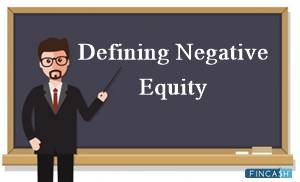Meaning of Negative Equity
When the cost of the asset falls below the outstanding balance on the mortgage that was used to acquire the asset, it is called negative equity. In simple terms, negative equity happens when the value of a debt-financed asset goes below the amount of the loan or mortgage owed to the Bank in exchange for the asset.

It usually happens when the asset's value rapidly depreciates over time, leaving the borrower with negative equity. It is computed by subtracting the outstanding mortgage balance from the current Market value of the asset.
How does Negative Equity Work?
It's crucial to first grasp what positive equity is before diving into negative equity. Positive equity refers to the owner's ownership of an asset that is funded by a loan.
For instance, a person purchases a property using a percentage of the money given in advance as a down payment. It qualifies as positive equity because the owner did not pay the full price for the house but still owns it. Positive equity tends to rise if the value of the borrowed asset rises or the amount owed to the bank in lieu of the asset falls.
On the other hand, negative equity happens when the value of the borrowed asset decreases or the amount owing to the bank in lieu of the asset increases. The difference between the associated mortgage and the sale price of the house becomes a debt to the owner when they sell it with negative equity.
Negative Equity and Its Implications
Negative equity can prevail in different scenarios. They are discussed below, along with their repercussions for the parties involved:
For an Asset
The negative equity concept is more prevalent in the housing and automobile sector. These assets are usually purchased with debt, such as a bank loan or a mortgage. A house's price might drop owing to shifting Real Estate values, while a car's price can drop due to quick use or Depreciation.
Negative equity occurs when the asset's value falls below the amount owed on the loan. Negative Amortization is a closely similar concept. When the asset's value remains constant but the loan's sum rises, it results in negative equity. The reason could be the borrower's failure to repay the lender in a timely manner.
Talk to our investment specialist
Net Worth
Net worth can be defined as the net worth of an individual. A person with negative equity is considered to have a negative net worth, which simply implies that his obligations outnumber his assets.
A student with an education loan is the best example of negative net worth. Although student loans enable people to obtain an education, which in turn improves their financial stability, they are not considered tangible assets. As a result, while the student loan is being repaid, the person who owns it has a negative net worth.
Shareholder Equity
The equity line column of the Balance Sheet might occasionally show a negative balance for publicly traded companies. It happens when a company's liabilities surpass its assets. In other words, when the total value of dividends given to shareholders and Earnings from previous periods exceeds the overall value of the company's losses.
An example of negative shareholder equity is when a firm pays out large dividends to its shareholders, the retained earnings are eroded, and the company's equity falls below zero. It's an indication that the firm is in financial trouble.
Negative Equity on Car
Negative equity on a car occurs when the current value falls below the amount you still owe the bank. It is a typical occurrence with long-term car loans, and the calculation is straightforward. The value of automobiles depreciates far faster because long-term vehicle loans are becoming more common and easily available, consumers are paying less than 20% of the car's worth as a down payment, and thus significant considerations such as an upside-down scenario go overlooked.
Negative Equity on Balance Sheet
When liabilities surpass assets, it results in negative equity on the balance sheet. It might be an indication that a firm is in financial trouble, or it could imply that the corporation has reinvested its retained earnings and any monies received from stock issuance in the company by acquiring expensive property, plant, and equipment.
Negative Equity on a House
When the amount of your house loan exceeds the value of your property on the market, it is termed as negative equity on the house. Understanding the factors that might cause equity to turn upside down and how this occurs might assist you in making more informed decisions when it comes to financing your property.
Negative Equity Example: Starbucks Negative Equity
Starbucks' payouts have remained quite constant over the last two years. The share repurchases have become increasingly aggressive, resulting in a loss of retained earnings. The retained earnings have become negative as a result of the fall in net Income and aggressive share repurchases.
Negative Equity Finance
Negative equity finance is a term used while purchasing a new automobile while still repaying your prior loan. The two automobile loan arrangements' payments are pooled and paid as one set monthly payment.
The Bottom Line
To sum it up, when you owe more on your mortgage than your asset is worth, you experience negative equity. Falling asset prices and high-interest loans are two reasons that might contribute to this. It can also be triggered by specific acts taken by a buyer throughout the asset purchase process, such as putting down a small down payment.
It might make selling or refinancing your asset more complicated. To avoid negative equity, try purchasing an asset at a low market price, higher down payment and purchasing an affordable asset.
All efforts have been made to ensure the information provided here is accurate. However, no guarantees are made regarding correctness of data. Please verify with scheme information document before making any investment.





